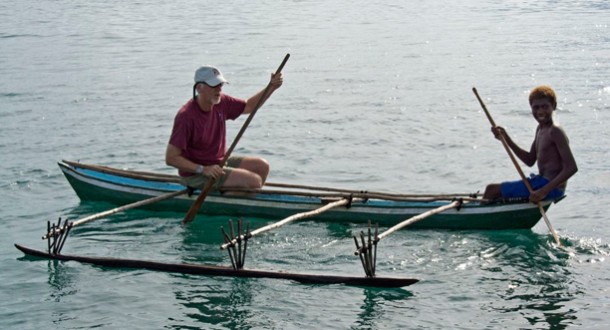Planning and Paddling

Jacquinot Bay, New Britain Island, Papua New Guinea
For the ninth day in a row, the tranquility of this majestic bay is undisturbed by wind or waves. From sunrise to sundown, the warm blue waters around the ship mirror the mountains to the north.
Each morning at 7 a.m., we have a planning meeting on the ship’s bridge. The ship’s captain and senior officers participate, as do the sub team, the lander team, the scientists, the small-boat team, and the divers. Our objective is to clarify technical problems and the steps needed to solve them. We choose our words carefully. When you’re developing and experimenting with systems that must work safely miles beneath the sea, you have to be accurate, brief, and clear.
This morning, under Jim’s direction, we discuss battery power management, push-core sampling procedures, 3-D camera technology, the sub’s flight characteristics, and the data bursts coming up from the sub. Dr. Doug Bartlett talks about microbes living in different layers of the sediments and how important the core samples are. Jim draws a sketch of what a more efficient push-core might look like, and Dave Goldie volunteers to make sure it gets built.
There’s a long discussion about the best site for the deep dive to 25,000 feet (7,620 meters). Jim and five others lean over the light table and computer screens and look at charts of the New Britain Trench. They see a steep-walled chasm slicing across the floor of the Solomon Sea. It’s an unknown place of mysterious currents, giant sharks, and unblinking squid. It’s called a trench, but somehow the word conveys too little of its size, complexity, and age.
I look around the bridge at the men and women on the DEEPSEA CHALLENGE team. Each is essential to the success of the mission. They represent a wide range of disciplines, including engineering, electronics, biology, business, filmmaking, medicine, and seamanship. Collectively they have thousands of hours of hard-won experience and enough professional talent to form the faculty of a small community college.
After lunch Jim, Charlie Arneson, John Bruno, and the 3-D film team—with a mule load of camera gear—climb into the Zodiacs and cross the water to the coastal village of Pomio. They step ashore on an empty, sunbaked beach, heft their cameras onto their shoulders, and head into town. Within minutes, the brutal sun and humid air make the cameras feel five times heavier.
There’s no one in sight. A few minutes later, school is out and the team is surrounded by young boys carrying books and machetes. There’s a lot of giggling and laughter, and they walk to a second beach where a dozen outrigger canoes are parked. Jim is maneuvered into one of the canoes and given a paddle. When he makes a great joke about it and dips the paddle into the ocean, there are elements of the uncomplicated boy in his eyes.
Late at night, the lander team is still working on the still and video cameras. Bruno Brunelle and Adam Gobi have cables laid out in the ship’s main hallway and are testing them for signal integrity. A few hours earlier, when I asked Larry Herbst if he’d had dinner, he told me how everyone feels about this project. “When this system is working, I’ll look after me.”
Photograph by Charlie Arneson



